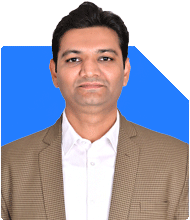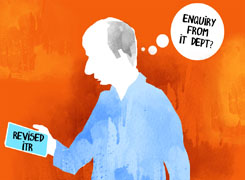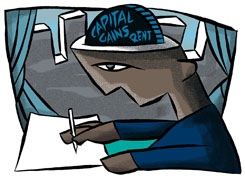Seeking Clarity: 35-Year-Old with 50 Lakhs - Invest or Repay Loan?
Ramalingam Kalirajan |8442 Answers |Ask -Follow
Mutual Funds, Financial Planning Expert - Answered on Jul 18, 2024
He has an MBA in finance from the University of Madras and is a certified financial planner.
He is the director and chief financial planner at Holistic Investment, a Chennai-based firm that offers financial planning and wealth management advice.... more

I am 35 years old and currently earning 2 lakh per month. Lately, I have been feeling disinterested in my work and contemplated taking a break for a couple of years. My husband also earns two lakhs monthly, and we have a loan of 1.25 crore. I have savings of 20 lakh, with 10 lakh in fixed deposits and 20 lakh in the provident fund. If I leave my job, I will receive around 20 lakh. I would like to know where to invest my 50 lakh and how effectively we can repay the loan using my husband’s salary.
Your Monthly Income: Rs. 2 lakh
Husband’s Monthly Income: Rs. 2 lakh
Total Loan Amount: Rs. 1.25 crore
Savings: Rs. 20 lakh
Fixed Deposits: Rs. 10 lakh
Provident Fund: Rs. 20 lakh
Expected Amount on Leaving Job: Rs. 20 lakh
Investment of Rs. 50 Lakh
Emergency Fund
Allocation: Rs. 5 lakh
Purpose: Cover unforeseen expenses
Investment: Keep in a high-interest savings account or liquid fund
Fixed Deposits
Current Allocation: Rs. 10 lakh
Recommendation: Continue with Rs. 5 lakh for short-term stability
Purpose: Low risk, moderate returns
Provident Fund
Current Allocation: Rs. 20 lakh
Recommendation: Continue
Purpose: Secure retirement savings, tax benefits
Mutual Funds
Allocation: Rs. 20 lakh
Type: Balanced mix of large-cap, mid-cap, and debt funds
Purpose: Long-term growth, risk diversification
SIP Investment
Monthly Allocation: Rs. 20,000 (from the remaining amount)
Type: Diversified equity mutual funds
Purpose: Regular investment, power of compounding
Loan Repayment Strategy
Current Loan
Total Loan: Rs. 1.25 crore
Using Husband’s Salary
Monthly Income: Rs. 2 lakh
Monthly EMI: Allocate 50% (Rs. 1 lakh)
Remaining for Expenses and Savings: Rs. 1 lakh
Lump Sum Payment
From Savings: Use Rs. 10 lakh
From Job Exit Amount: Use Rs. 20 lakh
Total Lump Sum Payment: Rs. 30 lakh
Purpose: Reduce principal amount, lower EMI burden
Monthly Budget Allocation
Husband’s Salary
Monthly Income: Rs. 2 lakh
Monthly EMI: Rs. 1 lakh
Expenses: Rs. 70,000
Savings and Investments: Rs. 30,000
Your Savings
Emergency Fund: Rs. 5 lakh
Mutual Funds: Rs. 20 lakh (lump sum)
Fixed Deposits: Rs. 5 lakh
Provident Fund: Continue with Rs. 20 lakh
Investment Strategy
Diversification
Balanced Approach: Mix of equity and debt
Risk Management: Diversify to reduce risk
Long-Term Growth
Equity Mutual Funds: Focus on large-cap and mid-cap for growth
Debt Funds: Stability and regular income
Regular Monitoring
Review Portfolio: Every six months
Adjust Investments: Based on performance and market conditions
Final Insights
Emergency Fund: Ensure it is readily accessible
Lump Sum Repayment: Focus on reducing debt
Regular Investments: SIP for long-term benefits
Review Strategy: Adjust based on financial goals
Best Regards,
K. Ramalingam, MBA, CFP,
Chief Financial Planner,
www.holisticinvestment.in
You may like to see similar questions and answers below
Jinal Mehta | Answer |Ask -Follow
Financial Planner - Answered on Feb 25, 2024
Ramalingam Kalirajan |8442 Answers |Ask -Follow
Mutual Funds, Financial Planning Expert - Answered on Jul 08, 2024
Dr Nagarajan J S K |401 Answers |Ask -Follow
NEET, Medical, Pharmacy Careers - Answered on May 15, 2025
Dr Nagarajan J S K |401 Answers |Ask -Follow
NEET, Medical, Pharmacy Careers - Answered on May 15, 2025
Dr Nagarajan J S K |401 Answers |Ask -Follow
NEET, Medical, Pharmacy Careers - Answered on May 15, 2025
Dr Nagarajan J S K |401 Answers |Ask -Follow
NEET, Medical, Pharmacy Careers - Answered on May 15, 2025
Dr Nagarajan J S K |401 Answers |Ask -Follow
NEET, Medical, Pharmacy Careers - Answered on May 15, 2025
Dr Nagarajan J S K |401 Answers |Ask -Follow
NEET, Medical, Pharmacy Careers - Answered on May 15, 2025
Vipul Bhavsar |83 Answers |Ask -Follow
Tax Expert - Answered on May 15, 2025
Vipul Bhavsar |83 Answers |Ask -Follow
Tax Expert - Answered on May 15, 2025
Vipul Bhavsar |83 Answers |Ask -Follow
Tax Expert - Answered on May 15, 2025
Vipul Bhavsar |83 Answers |Ask -Follow
Tax Expert - Answered on May 15, 2025























